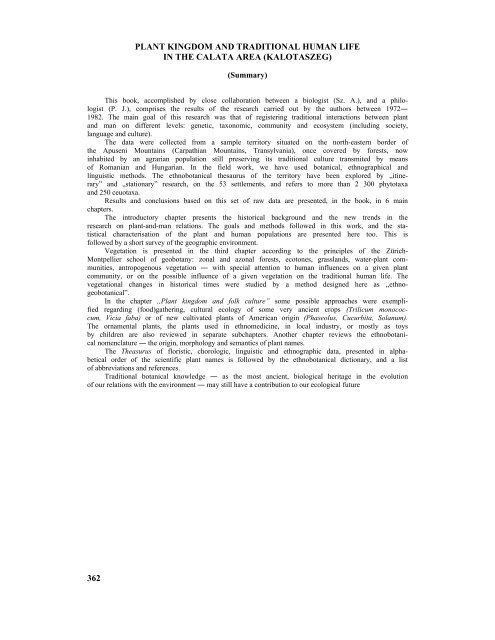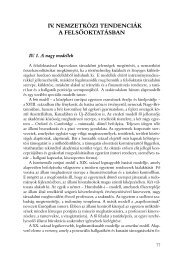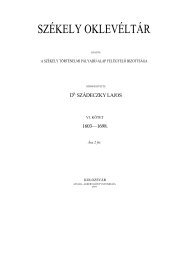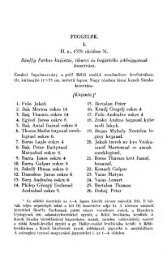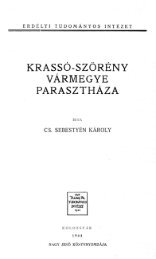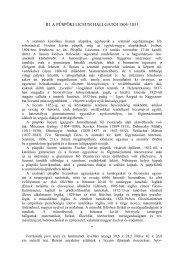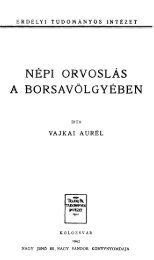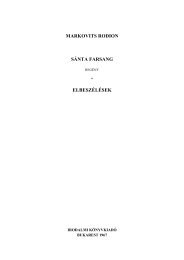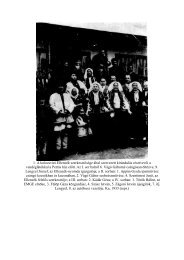- Page 1 and 2:
PÉNTEK JÁNOSSZABÓ ATTILAEMBER É
- Page 3 and 4:
ELŐSZÓÉletünk úgy alakult, hog
- Page 5 and 6:
BEVEZETÉSVisszatekintésA tudomán
- Page 7 and 8:
Etnobotanikai megközelítéssel (
- Page 9 and 10:
A rendszeres munkához szükséges
- Page 11 and 12:
1. ábra. Gyűjtési területünk h
- Page 13 and 14:
3. ábra. Gyűjtési alaptérképü
- Page 15 and 16:
2. táblázatKalotaszeg kultúrfló
- Page 17 and 18:
5. ábra. A különböző életform
- Page 19 and 20:
NépességKutatási területünknek
- Page 21 and 22:
eltartó képességén, a lakosság
- Page 23 and 24:
10. ábra. A terület földtani vá
- Page 25 and 26:
12. ábra. Földtani szelvény a do
- Page 27 and 28:
lépcső van, ezek a középső és
- Page 29 and 30:
14. ábra. A terület néhány font
- Page 31 and 32:
1. Adatközlő házaspár Jákótel
- Page 33 and 34:
7. Egerbegyi adatközlők8. Jegenye
- Page 35 and 36:
13. A dongói fennsík lekoptatottt
- Page 37 and 38:
20. Jellegzetes Nádas menti tájh
- Page 39 and 40:
26. A szűk völgyek nehezen megkö
- Page 41 and 42:
30. Melegkedvelő tölgyes-cseresta
- Page 43 and 44:
35. Égetéses legelőtisztítás (
- Page 45 and 46:
41. Az övezetalkotó fákként sz
- Page 47 and 48:
47. Zsombéksásos-tőzeges társul
- Page 49 and 50:
53. Színes virágpompájú pacsirt
- Page 51 and 52:
58. Gipszes, meszes padokon kialaku
- Page 53 and 54:
63. Keseknylevelű porcsinkeserűf
- Page 55 and 56:
69. Fekete üröm uralta varádics-
- Page 57 and 58:
74. Felhagyott agroterasz-rendszera
- Page 59 and 60:
80. Begyepesedett, keskeny padkáj
- Page 61 and 62:
88. Vadzabbal kevert változatos ge
- Page 63 and 64:
A NÖVÉNYTAKARÓKALOTASZEGNÖVÉNY
- Page 65 and 66:
különbözteti meg önálló nevek
- Page 67 and 68:
lett a történeti földrajzinév-a
- Page 69 and 70:
el arra járóknak válnak emlékez
- Page 71 and 72:
8. táblázatAz egyes növénynevek
- Page 73 and 74:
sulások leírása és jellemzése.
- Page 75 and 76:
3. Querco(petraeae)-Brachypodio-Cau
- Page 77 and 78:
2. Sphagno-Piceeturn (többnyire t
- Page 79 and 80:
szal a leggazdagabb, ilyenkor töme
- Page 81 and 82:
1970; Ehrendorfer 1973; Polunin 198
- Page 83 and 84:
Az Almás völgyében, Bábony kör
- Page 85 and 86:
18. ábra. Kocsánytalan tölgyes v
- Page 87 and 88:
Az égeresek társulástanl besorol
- Page 89 and 90:
a maradványfák révén jelzett, k
- Page 91 and 92:
Dongó határában, Kelecel és Ri
- Page 93 and 94:
ján írta le és adott tudományos
- Page 95 and 96:
Kardos peremizs-szarvas kocsord tá
- Page 97 and 98:
fejlődött állományok jellegzete
- Page 99 and 100:
A GYEPEKKalotaszeg területén az
- Page 101 and 102:
19. ábra. Csarabos-szőrfüves tá
- Page 103 and 104:
megjelenése enyhe sófelhalmozód
- Page 105 and 106:
20. ábra. Vöröscsenkeszes gyep s
- Page 107 and 108:
alakul ki, kisebb-nagyobb foltokban
- Page 109 and 110:
chis viciifolia) és tarka koronaf
- Page 111 and 112:
Csinos árvalányhajas társulás (
- Page 113 and 114:
Deres varjúháj-enyves aggófű t
- Page 115 and 116:
Dombividéki (félszáraz és szár
- Page 117 and 118:
Az úszó tündérrózsás társul
- Page 119 and 120:
menedéket. A legutóbbi időkben v
- Page 121 and 122:
Szíki kákás társulás (Schoenop
- Page 123 and 124:
pont, hogy a területen vágásnöv
- Page 125 and 126:
gyesek és gyertyánosok egykettőr
- Page 127 and 128:
szánthatóság utolsó fázisát j
- Page 129 and 130:
számos társulást jeleztek Nyugat
- Page 131 and 132:
Szúróslevelű gyomtársulások (O
- Page 133 and 134:
mosodás elsősorban erdei útjaink
- Page 135 and 136:
Szántási lépcsőnek vagy hagyom
- Page 137 and 138:
NÖVÉNYVILÁG ÉS NÉPI KULTÚRAGY
- Page 139 and 140:
társsal a csalán, a turbolya, a k
- Page 141 and 142:
ének a levét fogyasztották. A sa
- Page 143 and 144:
csak disznóval etették a kakascí
- Page 145 and 146:
9. táblázatNövényi eredetű ala
- Page 147 and 148:
10. táblázatA búzanemzetség fel
- Page 149 and 150:
25. ábra. Az alakor (Triticum mono
- Page 151 and 152:
26. ábra. Az alakor géneróziója
- Page 153 and 154:
A behozott próbák fajösszetétel
- Page 155 and 156:
hasonló hüvelyes növényeket (mi
- Page 157 and 158:
is. Európában a nemesítőket a h
- Page 159 and 160:
névvel jelölik az egyes babfajtá
- Page 161 and 162:
A burgonya népi terminológiája i
- Page 163 and 164:
sust, azaz a csicsókát jelölő p
- Page 165 and 166:
szívták (lopták) ki a hordóból
- Page 167 and 168:
archaikusat, a hagyományosat és a
- Page 169 and 170:
kerti oroszlánszáj (Antirrhinum m
- Page 171 and 172:
gebb szilágysági, a hidegebb Kapu
- Page 173 and 174:
(6) Meglehetősen nagy mennyiségi
- Page 175 and 176:
gyományokat őrző sírdíszeket.
- Page 177 and 178:
nított, vélt vagy valóságos hat
- Page 179 and 180:
tak. A görcsoldóként már említ
- Page 181 and 182:
ták. Valószínűleg ugyancsak a s
- Page 183 and 184:
tövis (Silybum marianum: Nk, Sz),
- Page 185 and 186:
cinale) gyökeret tesznek (Gy, Gym,
- Page 187 and 188:
is lemossák vele (Mv); a réti per
- Page 189 and 190:
Felfedezhetünk nem egy archaikus v
- Page 191 and 192:
94. A zöldpaszuly a zöldségpiac
- Page 193 and 194:
101. Konyhakerti vetőmagtartó lá
- Page 195 and 196:
108. Violás virágosládák tetőt
- Page 197 and 198:
116. Henye boroszlán (Daphne cneor
- Page 199 and 200:
120. Épülő faház, szakállszár
- Page 201 and 202:
125. Kender- és szénaszárítás
- Page 203 and 204:
130. Durván faragott kiskapu (Kalo
- Page 205 and 206:
136. Japánakác (Sophora japonica)
- Page 207 and 208:
140. Orvosi ziliz (Althaea officina
- Page 209 and 210:
144. Fazékban nevelt kígyókaktus
- Page 211 and 212:
148. Dísznövényként nevelt füg
- Page 213 and 214:
154. Tarka kosbor (Orchis tridentat
- Page 215 and 216:
darabot, a szuszékot bükkfából
- Page 217 and 218:
Madártésztát is szoktak sütni,
- Page 219 and 220:
JELEK, JELKÉPEK, HIEDELMEKA kultú
- Page 221 and 222:
ősi hitvilág rég széttöredezet
- Page 223 and 224:
A termékenységvarázslás eszköz
- Page 225 and 226:
ne kellemes asszociációkat kelten
- Page 227 and 228:
A NÉPI NÖVÉNYNEVEKA NÖVÉNYNEVE
- Page 229 and 230:
kascserge a ţolu lupului vagy lepe
- Page 231 and 232:
A kicsinyítő-becéző származék
- Page 233 and 234:
(csúcsos eper, kerek eper stb.), a
- Page 235 and 236:
Odúsfa-típus. Nem növénynév, e
- Page 237 and 238:
jából, és aztán fokozatosan fel
- Page 239 and 240:
víz mellett is gyakori, más, sár
- Page 241 and 242:
A népi növényismeret tehát itt
- Page 243 and 244:
virítóbb, legfeltűnőbb színek
- Page 245 and 246:
A növényekhez fűződő sokféle
- Page 247 and 248:
A metaforák következő nagy csopo
- Page 249 and 250:
acris’, a vadcsombord ’Thymus
- Page 251 and 252:
AABIES Mill. (Pinaceae)A. alba Mill
- Page 253 and 254:
kerti példányok nagyobb közinté
- Page 255 and 256:
hagymával; fokhagymás beöntést
- Page 257 and 258:
Nd). A többi ponton általában n
- Page 259 and 260:
tekben, faluszéleken gyakori terme
- Page 261 and 262:
ATHYRIUM Roth (Athyriaceae)A. filix
- Page 263 and 264:
szőrös nyír; mesteacăn pufos. E
- Page 265 and 266:
B. sterilis L. ! meddő rozsnok. Eu
- Page 267 and 268:
C. sibirica L.; pongyola harangvir
- Page 269 and 270:
ecta (Fleischer) A. et G.: Ct, Gym,
- Page 271 and 272:
pannonica. Sz; C. x plecskaensis Ny
- Page 273 and 274:
coreana em. hoc loco (simplices, se
- Page 275 and 276:
COELOGLOSSUM Hartm. (Orchidaceae)C.
- Page 277 and 278:
a terminológia is tükrözi ezt a
- Page 279 and 280:
- A töklevél üreges szárából
- Page 281 and 282:
DAPHNE L. (Thymelaeaceae)D. cneorum
- Page 283 and 284:
DIPSACUS L. (Dipsaceae)D. fullonum
- Page 285 and 286:
E. arvense L. ! mezei zsurló; barb
- Page 287 and 288:
*E. marginata Pursh, jégvirág. E-
- Page 289 and 290:
eper (It) | kapsonyeper (Gyv) | ker
- Page 291 and 292:
G. palustre L.; mocsári galaj. Eua
- Page 293 and 294:
GYPSOPHILA L. (Caryophyllaceae)*G.
- Page 295 and 296:
H. tristis L.; szomorú estike; mir
- Page 297 and 298:
HYPERICUM L. (Hypericaceae)H. elega
- Page 299 and 300:
Zt); tökös dijó nagy termésű (
- Page 301 and 302:
1960 körülig, Va-on, Zs-on 1970-i
- Page 303 and 304:
Hajdani jelentőségét az is bizon
- Page 305 and 306:
*L. usitatissimum L.! termesztett l
- Page 307 and 308:
MMAHONIA Nutt. (Berberidaceae)*M. a
- Page 309 and 310:
(Bh) || Ro. lucérnă (Dr, N), luţ
- Page 311 and 312:
epërfa (Bh, Gym, K, Kd, Kf, Kszt-Z
- Page 313 and 314:
hány (Va) || Ro. tutún (Be, Ct, C
- Page 315 and 316:
OROBANCHE L. (Orobanchaceae)O. alba
- Page 317 and 318:
terjedésére nézve 1. Szabó-Pén
- Page 319 and 320:
fajnál a változatos tájfajtákat
- Page 321 and 322:
11.01: akácpaszuj (Ny) | fehírsz
- Page 323 and 324:
A hordós káposzta közé tették,
- Page 325 and 326:
PLECTRANTHUS L'Hérit. (Lamiaceae)*
- Page 327 and 328:
POTENTILLA L. (Rosaceae)P. alba L.
- Page 329 and 330:
elü (Mb), mórabelü szilva piros
- Page 331 and 332:
P. pyraster Burgsd. incl. P. achras
- Page 333 and 334:
RAPISTRUM Crantz (Brassicaceae)R. p
- Page 335 and 336:
van a rózsa-motívum különféle
- Page 337 and 338:
gensis Sprib. = R. caesius x R. vul
- Page 339 and 340:
illetve temetőben mint a meghalt k
- Page 341 and 342:
hogy találkozzanak a legénnyel: ,
- Page 343 and 344:
Közönséges gyom. Nt. lapisfű (N
- Page 345 and 346:
SORBUS L. (Rosaceae)Nt. barkócafa
- Page 347 and 348:
Ms. Bizonyára a területen is. - A
- Page 349 and 350:
THELYPTERIS Schmidel (Thelipteridac
- Page 351 and 352:
(*)T. pratense L. ! réti (vörös)
- Page 353 and 354:
ágásokon (kapun, utcaajtón stb.)
- Page 355 and 356:
ördögrakoja (Gyv, Mv) | ördögra
- Page 357 and 358:
tömeges: Kf, a Ríszeg alatti föl
- Page 359 and 360:
tak vele szeplő ellen (Mb). - Ha g
- Page 361 and 362:
(Sz!). Nt. duplafokszija (J) | kakt
- Page 363 and 364:
2. A MAGYAR NÉPI NÖVÉNYNEVEK JEG
- Page 365 and 366: erek (vízparti) liget(erdő) (hely
- Page 367 and 368: cirok Sorghum bicolorciróka 1. fű
- Page 369 and 370: dohány Nicotiana rusticadohányvir
- Page 371 and 372: fehér nárcisz Narcissus poeticusf
- Page 373 and 374: gránátpuszulyka Phaseolus vulgari
- Page 375 and 376: juhgomba RussulaJuliskafuszulyka Ph
- Page 377 and 378: kígyókaktusz Aporocactus flagelli
- Page 379 and 380: leveles kaktusz Phyllocactus ackerm
- Page 381 and 382: moharózsa Rosa moschatamohos Sphag
- Page 383 and 384: pelargónia Pelargonium zonale + P.
- Page 385 and 386: ózsapaszuly Phaseolus vulgaris con
- Page 387 and 388: százszorszép 1. Bellis perennis,
- Page 389 and 390: töltenivaló [paprika] Capsicum an
- Page 391 and 392: vérgyökér Sanguisorba officinali
- Page 393 and 394: ube dulci Lathyrus tuberosusbujor O
- Page 395 and 396: crudă Impatiens balsaminacrumple S
- Page 397 and 398: lăcrămioare Convallaria majalisl
- Page 399 and 400: ovăz Avena sahvaovăz turcesc Aven
- Page 401 and 402: piţulofiu Lysimachia nummulariapiz
- Page 403 and 404: stînjen albastru Iris germanicast
- Page 405 and 406: RÖVIDÍTÉSEKA kutatópontok nevé
- Page 407 and 408: Bokdam-Droogers 1975: Bokdani, J. -
- Page 409 and 410: Hiepko-Schultze-Motel 1981: Hiepko,
- Page 411 and 412: Nyárády 1941-44: Nyárády E. Gy.
- Page 413 and 414: Soó 1949: Soó Rezső, Les associa
- Page 415: LUMEA VEGETALĂ ŞI CULTURA TRADIŢ
- Page 419 and 420: CONTENTSPrefaceIntroductionHistory
- Page 421 and 422: TARTALOMElőszóBevezetés (Sz. A.,


